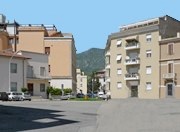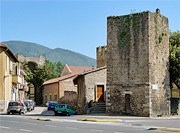



Piazza Tre Monumenti Porta Spoletina (Porta Tre Monument)
The existence of three important monuments in Terni is documented in 1315 by a reference to the “pontem Trium Monumentorum” (the bridge of the three monuments). This crossed the forma nova, a canal that had been built in the 13th century outside the then city walls: when the circuit of walls was extended in ca. 1354, the gate here (now Porta Spoletina) was often called Porta Tre Monumenti.
In 1590, Giovanni Battista Castelli commissioned two large monuments for the garden of his villa near Porta Spoletina, with an inscription that recorded that they were based on two Roman monuments nearby. These were believed to commemorate:
-
✴the Emperor Tacitus (275-6 AD); and
-
✴his half-brother and successor, the Emperor Florianus (276 AD).
This tradition was based on the chapter of the Historia Augusta (probably 4th century AD) on the lives of these emperors, in which the author(s) comment: “So then there arose two princes from one house, of whom the one ruled for six months and the other for scarce two .... Their two statues, made of marble and thirty feet in height, were set up at Interamna: for there, cenotaphs were erected to them on their own land, but these were struck by lightning and so thoroughly broken that they lay scattered in fragments” (Life of the Emperor Tacitus, paragraphs 14-5).
At the time that Castelli had the replicas made, the remains of the original monuments apparently survived on nearby land that belonged to the Simonetta family. In his “Storia di Terni” (1646), Francesco Angeloni recorded that Pope Pius V ordered Pietro Simonetta to demolish them in 1568. The source of this information was Pietro’s grandson, Paolo Simonetta, who also gave Francesco Angeloni a number of coins from the reigns of the two emperors that had apparently been found on the site at that time. Paolo Simonetta claimed that a third monument that was destroyed at this time had belonged to the historian Gaius Cornelius Tacitus (died ca. 117 AD), and he justifies the destruction on the grounds that Tacitus had been anti-Christian. There is however no evidence that he came from Terni, and the claim in the Historia Augusta that the Emperor Tacitus was a descendant of his family is usually discounted.
In 1907, a Roman necropolis was found to the east of Viale della Stazione that contained (among other remains) the bases of three funerary monuments. These were presumed to be the remains of the monuments of the “tre Taciti” (of the three members of the gens Tacitus), and the location became known as the Piazza Tre Monumenti. However, Giuseppe Sordini, among others, strongly questioned the evidence for this identification.
The inscription on a Roman statue (1st century AD) on the first landing of the external staircase in the courtyard of Palazzo Manassei makes the somewhat speculative claim that this is the effigy from the monument of Gaius Cornelius Tacitus. The statue was found in the 19th century in Via Tre Monumenti and the Manassei family acquired it because they claimed that their palace was built on the site of the family home of the Emperor Tacitus.
Read more:
C. Angelelli, “Iscrizione Commemorativa dei Monumenti degli Imperatori Marco Claudio Tacito e Marco Annio Floriano”,
in A. Ciccarelli (Ed.), “Arte e Territorio: Interventi di Restauro” (2006) Terni pp332-42
Return to Monuments in Terni.
Return to the Walk II.

